The time has come, the reviewer said
To speak of many things:
Of knives and pots, and evil eyes
And creepy doll-faced beings.
Of hidden paths and sidequests,
And pig-snouts sporting wings.
All this and more, after the jump.
Alice: Madness Returns, a direct sequel to the 2000 PC game American McGee’s Alice, is a very typical platform game that seems to take its inspiration from many sources before placing them into the strange melting pot that is Wonderland. A dash of Ratchet and Clank, a pinch of Batman: Arkham Asylum. A generous helping of Prince of Persia for good measure, with a hint of Darksiders. And since it’s a direct sequel to an old game, odds are that, unless you’re as old a gamer as I, you will not have played the original. What a good thing, then, that an HD remake of the original Alice is available (free if you have a new copy of Madness Returns, for a small price if you’ve gone and bought it second-hand)! It’s not necessary for you to play the original to understand what’s happening in Madness Returns, but playing it will impart a lot of background information that you would otherwise have to infer from Madness Return’s events.
In short, Madness Returns takes place almost immediately after the end of the first game (which itself occurs shortly after the events of Through the Looking Glass). Alice’s family had burned to death in their home, and Alice feels brick-laden hodloads of guilt over having caused the fire. So much guilt, in fact, that she had gone bat bogglingly, spleen-curlingly insane from it. Wonderland, then, in case you haven’t figured it out yet, represents Alice’s dippy state of mind. Throughout the game, Alice switches between 19th century London and Wonderland (ostensibly her working through her insanity). The idea, of course, being that if she manages to fix Wonderland, she can manage to fix her own cheese-holed brain, and through her new adventures come to terms with her own grief.
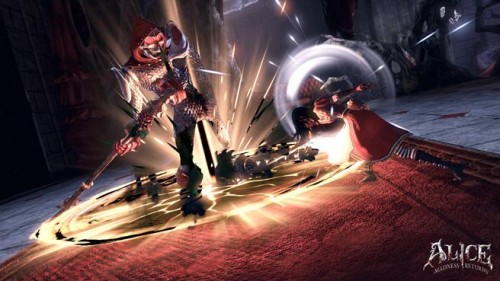
Each new level in Wonderland itself starts off as an incredibly pretty, colorful place, but it soon descends into the kinds of greys and browns that FPS gamers should be comfortable with. I guess this is to indicate that although Alice looks quite sane on the surface, there is a lot of inner darkness and turmoil to overcome. The game is graphically beautiful and disturbing in turns, and the rich, imaginative environments must be commended. It’s a huge pity, then, that the cut scenes are depicted in a cardboard-cutout-and-paper format, quite unlike the game itself. Aside from the thinly-veiled references to the book, no decent reason is given for this art direction, and it jars quite heavily with the rest of the style and feel of the game.
The game has a decent exploration feel to it, but the environments are not quite complex enough for you to require a map of any sort. Which is perfect, because you don’t get one. Want to know where you are? Tough. It’s a testament to the skill of the level designers that, despite the level complexity, you never really feel as if you need one, though. The level layout is well signposted so you don’t get lost, and yet despite all this, there are still plenty of secrets to locate. And lordy are there secrets and things to collect! The game’s currency, teeth, is abundant enough (although the only use you have for them is to upgrade your weapons), but you’ll find that there are also disembodied pig-snouts to be peppered, Alice’s lost memories to find, roses paint to collect (to expand your health meter), special challenge rooms to complete, and the occasional puzzle to solve.
On top of that, in the first level of the game Alice gains the ability to shrink at will, and shrinking allows to you see things that you would not ordinarily be able to (called “Shrink Sense” in the game). This not only includes seeing the world from a different perspective, but also lights up hidden scribbles on the walls that point Alice in the direction of secrets, and lights up hidden platforms dotted throughout each level. Shrink Sense, in a sense, works much like Batman’s “detective mode” in Arkham Asylum. The clever difference here is that you can’t jump or fight while using Shrink Sense, so any hidden elements that are revealed gradually return to their hidden state when you leave shrink mode. It also means that, since Madness Returns is a platform game, you cannot stay in a shrunkified state forever. A good amount of the platform-hopping reminded me a lot of playing Prince of Persia: Forgotten Sands with the artful orchestration of your fingers on the controller as you try to keep the platforms in view and jumping at the same time.
It’s another big pity that, despite the delightful environments, the actual level design is horribly repetitive. Horribly repetitive. Horribly repe… *bleep* Sorry. The same few platform mechanics appear over and over and over and over and …well, over again. And then, for good measure, over again. Unlike Prince of Persia: The Forgotten Sands where new gameplay mechanics kept materializing to keep the level design fresh and keep you on your princely toes, Madness Returns introduces everything in the first level, and keeps repeating the same designs. There is a lot of emphasis on floating around, for example, to get from one spindly platform to the next, incredibly distant platform. Not being content to have the standard double-jump mechanism seen in so many platformers, Madness Returns also gives Alice the ability to quadruple jump, and this, along with the floating mechanism means that the levels are incredibly spread out, with lots of wild tufts of nothing interspersed with huge tracts of empty in between. It means, of course, that there is a lot of place to fall into, so I hope you enjoy missing platforms, because you are going to do it a lot.
Speaking of empty levels, the game relies heavily on the platforming as its main gameplay mechanic. So Wonderland’s denizens from the first game are almost nowhere to be found, and those that exist are largely unresponsive, but given that Wonderland represents Alice’s state of mind, I can forgive this oversight as long as it serves the greater purpose of the story. The only question I have here is: does it? I leave it as an exercise to the reader to figure it out. [Ed: In other words, you don’t know?]
Like the level design, the monster encounters are widely spaced. In one sense, it is a good thing because these battles can sometimes be quite lengthy, especially at later levels with the tougher foes. Early on in the game, you receive your first two weapons: the vorpal blade for close-range battle, and the pepper grinder (more a hand-cranked minigun than anything else) for peppering your enemies at a distance, and the weapons have a very satisfying, almost solid feel to to them. Later on you’ll get the even heavier hobby horse and teapot cannon weapons. I must say I love the weapons in this game. There’s a very pleasantly meaty “thunk” when the pepper grinder scores hits on enemies, and the hobby horse is, satisfyingly, more fun than a barrel of sledgehammers. Ok, maybe not that much fun, but it’s damned close. An interesting point to the battles is that when Alice is on her last bit of health you can activate a mode called “Hysteria”, which supercharges Alice, allowing her to make quick kills. The method of activation, however (clicking the analog stick),is a terrible design choice. Because you use the left stick to move around as well, hysteria occasionally activates when you least want it.
The worst aspect of Madness Returns, unfortunately, is the camera. The game suffers from what I like to call ‘Epic Mickey Syndrome’, although thankfully not as fatally chronic. There are sections in the game where well-timed, quick jumps are essential to progress, however. I fear that the malicious b@$t@rd of a camera has killed me far more than any of the enemies have ever done, especially with the trickier sections. While we are discussing camera control, the game also allows you to focus on an enemy while under attack, but this, too, can get a little…Epic. In frenetic battles, while focused, you cannot see what’s going on around you. On the other hand, you also cannot attack with the ranged weapons effectively if you are not focused on an enemy. It’s a frustrating catch-22 situation. This leads, unfortunately, to another, admittedly minor, poor aspect of the game: the way you select enemies while focused. For some odd reason, this was assigned to the right analog stick (normally assigned to the camera), despite the shoulder buttons doing nothing while in focus mode anyway. This meant that, while I was unsuccessfully trying to manipulate the camera in focus mode, I was losing the target I had originally chosen. It’s a horrible design choice, and there is no way of changing this in the options.
Overall, however, Madness Returns is still decent fun with beautiful environments and a really brilliant, if incredibly dark story. The game’s age restriction (18) is quite warranted, due in part to the disturbing nature of the story, and partly to the gore factor. Given the sheer number of things to find, this game will likely also keep you busy for a fair chunk of time. If you are a fan of platform games such as Prince of Persia or Ratchet and Clank, or games with a heavy collection bent such as Darksiders, you will, as I did, thoroughly enjoy Madness Returns.
Score: 7 out of 10 prawns.
Detailed information:
Distributor: EA
RRP: R450 (PS3 and Xbox 360)
Release date: 16 June 2011
Age rating: 18


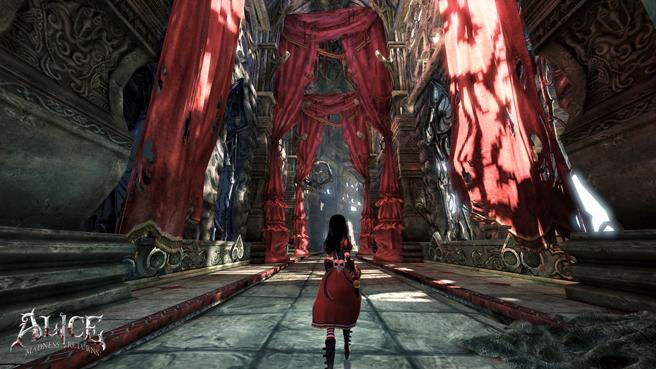
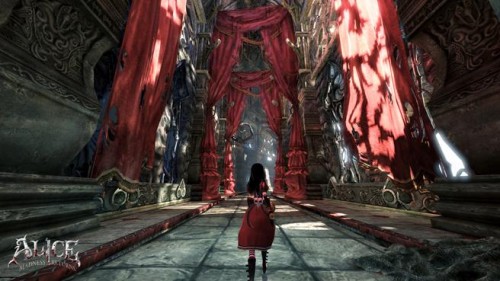
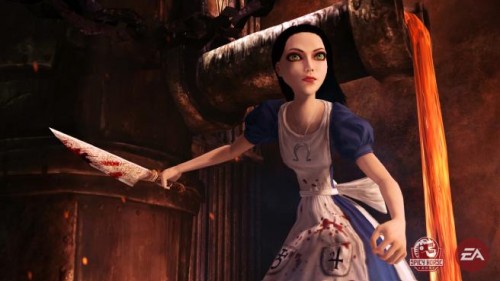
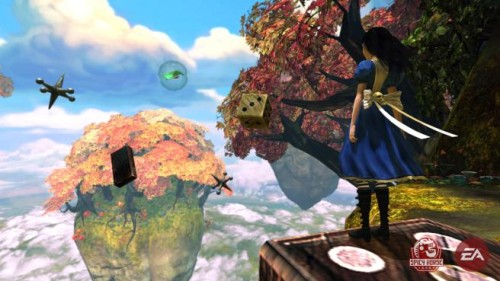
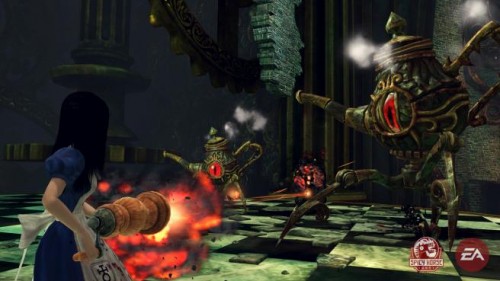
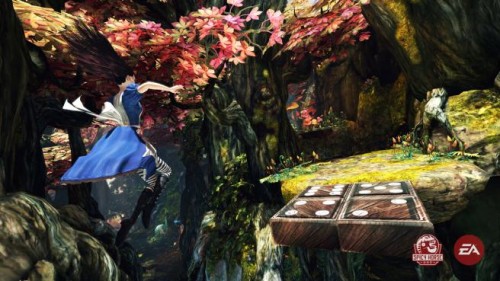
2 replies on “We Review: Alice: Madness Returns”
When I first started playing this game I really liked it. I like all the colours and wierd animals and stuff. However once I started getting into it it drove me bat crazy. The jumping mechanics are quite poor in my opinion and she can’t grab onto ledges. I’ve died so many times jumping. Also those damn bottle fly things are such a pain. The camera also sucks as you mentioned in the review.
I’ve shelved this game and will return to it when I’ve finished playing all my other new games.
I didn’t mind so much the inability to grab ledges. It’s a game mechanic I’ve had to deal with in older games, so not a big deal, but the camera…oh man, the camera! If you managed to get as far as the catacombs in the second world, you’ll know what I’m talking about when I say the camera is killer. If you have a bit of patience, however, and if you play games for their stories, you’ll find the story of Madness Returns quite rewarding.